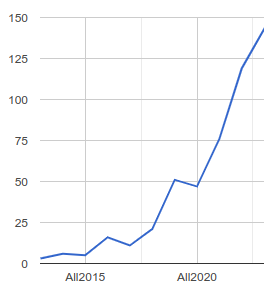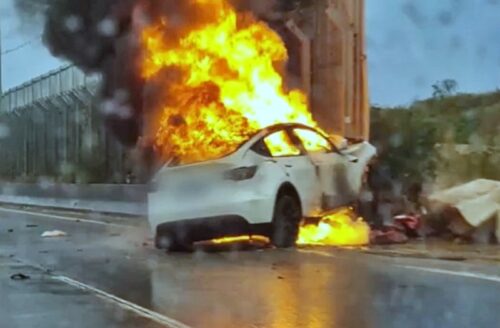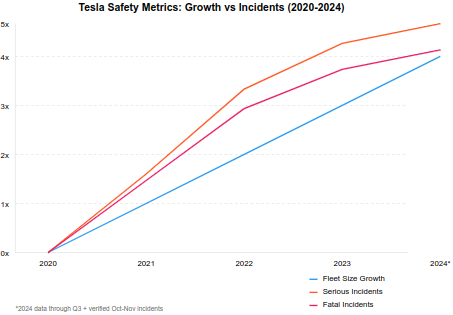First, you have to wonder just how many more people must die (as dutifully reported by TeslaDeaths.com) before Tesla is properly banned from public roads?
Tesla Deaths Per Year

Remember, the Ford Pinto had killed around 25 people (as told by Ford) when the entire country had to shift into gear in order to regulate against safety design negligence by car makers.

Front doors jam shut preventing escape or rescue from a burning car? That sounds just like a Tesla! Except Tesla is on track to kill 25 people per month! How are they legal?
I mean do we expect a market to somehow adjust itself today such that people stop owning Tesla, as well as stop riding in and around them? I have doubts about such consumer self-correction as I still weekly read news from grieving families who say, too late, they never understood the very fast growing risk of their loved ones being burned alive, hit head-on or run over by Tesla.

And on this tragic note about the exploding number of deaths in defective cars, which seem to only be stopped with regulation, Tesla has many shockingly old safety design defects. Consider for comparison an assorted list of high safety models, from far better engineered brands.
- Acura MDX four-wheel-drive
- Audi Q5 four-wheel-drive
- Chevrolet Traverse four-wheel-drive
- Lexus RX 350 four-wheel-drive
- Mercedes-Benz E-Class sedan four-wheel-drive
- Porsche Macan
- Subaru Ascent
- Toyota C-HR
- Volvo XC60 four-wheel-drive
There are even more options than these, because it’s apparently easy to post better safety results than the high-priced low-quality “luxury” Tesla. This reference is only to show many cars achieve extremely low death rates in the latest real world results (NHTSA Fatality Analysis Reporting System). In other words, no Tesla achieves what others can.

The IIHS emphasizes another angle on the data as well. They say marketing of the technology has as much to do with high death tolls as the designs themselves, or perhaps even more impact.
The explanation may lie in the image of the vehicles. Luxury cars are associated with ease and comfort. In contrast, the [most deaths] on this list are associated with [dangerous behavior suggestions that] influence how they’re driven. […] Marketing for the Dodge Charger HEMI, for example, focuses on its “ground-shaking” power, its acceleration “bolting off the line” and its “racing-inspired” high-performance brakes, while the Chevrolet Camaro promises buyers the ability to “dominate on the daily” with an “extreme track performance package” and the Ford Mustang offers “adrenaline chasers” the power to “keep ahead of the pack.”
Tesla’s infamously thoughtless “appetite for destruction” strangely isn’t mentioned in this paragraph, even though the brand is regularly posting dangerous behavior suggestions… such as their CEO boasting to customers that “accidents probably won’t happen” when they drive drunk or fall asleep at the wheel.
The latest NHTSA formal defect investigation letter to Tesla that the company must stop false advertising of “driverless” capabilities seems to fit. Tesla might be the most causal relationship of all, given repeated fraudulent safety statements leading directly to high death rates. I’d still argue Tesla engineering defects are a significant factor, however. No other brand has been reporting multiple cases of everyone inside being burned to death (again and again), for one obvious example, given the notorious “death trap” design defect that seals Tesla doors shut after a crash.

Are you driving the deadliest car in the world?
To put it another way, in 1971 a new agency (NHTSA) was pushing the first major safety regulations, against the desires of a hugely popular racist president Nixon. The “pro business” President expressed a list of clear disdains:
- Environmental protection (“fighting a delaying action”)
- Consumer advocacy (“Naderism”)
- Safety regulations (“greatly exaggerated”)
- “Environmentalists and consumerism people” who he claimed were “enemies of the system”
Most tellingly, Nixon dehumanized people if they were concerned with the environment, literally calling them animals and a threat:
…we can’t have a completely safe society or safe highways or safe cars and pollution-free and so forth. Or we could have, go back and live like a bunch of damned animals. […] They’re not one damn bit interested in safety or clean air. What they’re interested in is destroying the system.
He went even further to turn his comments racist and target Native Americans, as if to build a “white man” argument against environmental progress:
You see, what it is, too, is that we are, we are now becoming obsessed with the idea that … progress … industrialization, ipso facto, is bad. The great life is to have it like when the Indians were here. You know how the Indians lived? Dirty, filthy, horrible.
And so does anyone really think that the Tesla and Trump Whitehouse will reveal anything different than Ford and Nixon did with the Pinto? Hint: Ralph Nader refers to Tesla as manslaughter.
Transcripts reveal for historians how Nixon fundamentally sided with industry over public safety and environmental concerns, viewing regulation as an attack on business rather than an innovation engine for protection of people. He acted to delay critical safety requirements (like airbags) after meeting with car executives, proving himself to be a corrupt (ultimately criminal) President who dangerously prioritized big corporate short-term interests over sustainable investments and public safety.
Related: Tesla topped iSeeCars list of most dangerous car brands with an almost unbelievable crash frequency that has climbed to 5X the number of Tesla being produced.
